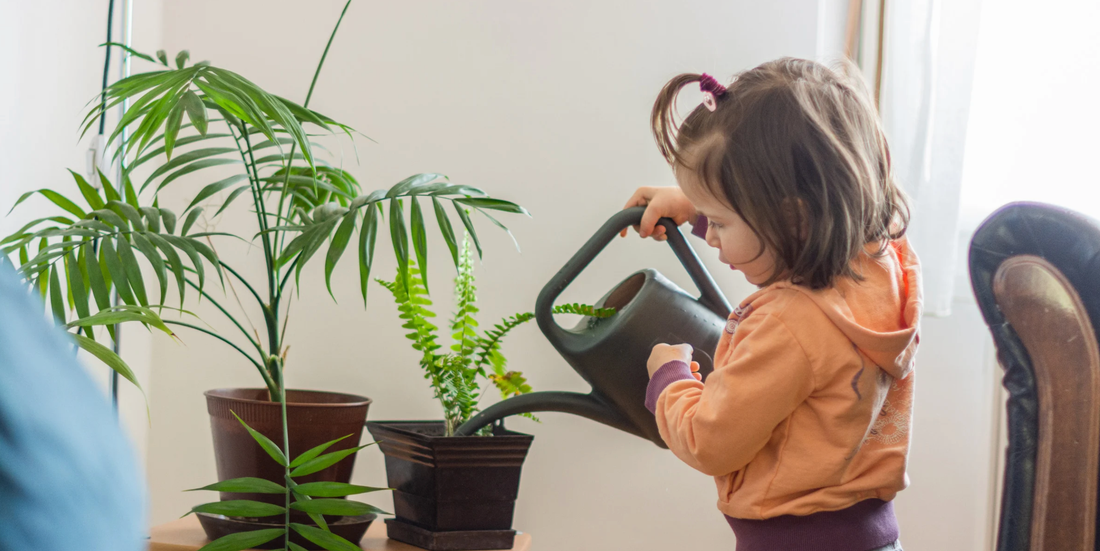Overwatering is one of the most common reasons houseplants struggle or die. Even the most well-meaning plant parents often think their plants need more water than they actually do. Understanding the signs, causes, and solutions to overwatering can help you keep your plants healthy and thriving.
Why Overwatering Is a Problem
When soil stays wet for too long, the roots can’t breathe. Plant roots need both air and moisture to function. Constantly soggy soil suffocates the roots and creates the perfect environment for fungal growth, which leads to root rot.
Root rot is the most severe consequence of overwatering. It causes the roots to turn brown or black, become soft and mushy, and eventually stop absorbing water and nutrients. Once root rot sets in, your plant’s leaves may wilt, yellow, or drop even though the soil is still wet.
Signs You Are Overwatering
-
The soil stays damp for days after watering
-
Leaves are yellowing or turning brown, especially near the base
-
The plant looks wilted, even though the soil is moist
-
Mold or fungus is growing on top of the soil
-
The pot smells musty or sour
-
You notice fungus gnats flying around
-
When removed from the pot, the roots are dark, soft, or slimy
If several of these signs appear, overwatering is likely the problem.
The Real Causes of Overwatering
Overwatering isn’t just about adding too much water at once. It’s often caused by a combination of factors:
1. Pots Without Drainage Holes
A pot without drainage holes traps excess water at the bottom, keeping roots constantly wet. Always use a pot with proper drainage so excess water can escape.
2. Pots That Are Too Large
A pot that’s too big for your plant holds more soil than the roots can handle. Extra soil retains moisture longer, keeping roots damp for too long. It’s better to size up gradually — usually only one or two inches wider than the current pot.
3. Poor Soil or Compact Potting Mix
Dense, heavy soil that holds water can suffocate roots. Tropical and indoor plants prefer a light, well-aerated mix that drains quickly. Look for potting mixes designed for houseplants or tropicals, such as Maya’s Growing Mediums from Urbane Eight.
4. Watering Too Frequently
Many plant owners water on a schedule instead of checking the soil first. Watering when the top inch of soil is still moist leads to waterlogged roots over time.
5. Low Light or Cool Temperatures
Plants in low light or cooler rooms use less water because their growth slows down. If you water them as often as your brighter, warmer plants, they can easily become overwatered.
How to Fix an Overwatered Plant
Stop Watering and Let the Soil Dry Out
Hold off on watering until the top half of the soil feels dry.
Check the Roots
Gently remove the plant from its pot. If the roots are soft, black, or smell bad, trim away the damaged sections with clean scissors.
Repot with Fresh, Well-Draining Soil
Replace the old, soggy soil with a fresh mix designed for drainage and airflow. Ensure the new pot has drainage holes.
Adjust Your Watering Routine
Going forward, water only when the top inch of soil is dry. Consider using a moisture meter to check soil levels accurately before watering.
Improve Lighting and Airflow
Move the plant to a brighter area or increase air circulation so the soil can dry more evenly.
Use the Right Tools
A good watering can with a narrow spout gives you better control over how much water you add. (Insert link to Urbane Eight’s watering cans here.)
How to Prevent Overwatering
-
Always choose pots with drainage holes
-
Use high-quality, airy potting mix for your plant type
-
Avoid pots that are much larger than the root ball
-
Empty saucers of standing water after watering
-
Water less often in winter when growth slows
-
Monitor humidity and light — plants in dim rooms will dry out more slowly
-
Use a moisture meter or do a simple finger test before watering
Final Thoughts
Overwatering is one of the easiest mistakes to make, but also one of the easiest to fix. The key is understanding your plant’s needs, choosing the right pot and soil, and paying attention to how quickly the soil dries. With a few small changes — like checking moisture levels before watering and using pots with good drainage — you can prevent root rot and keep your houseplants strong and healthy.
At Urbane Eight, you’ll find everything you need to keep your plants thriving, including moisture meters, drainage-friendly pots, watering cans, and premium potting mixes.




